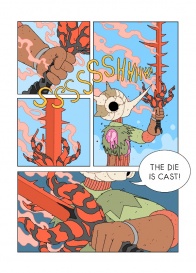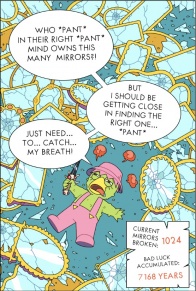The webcomic creator is never far from their audience. Be it through social media, public email addresses, Discord servers, or simply the comments section beneath a page, there is a rapport and a conversation that is developed that is unique to the medium. We’re continuing those conversations here, albeit a little more formally, by interviewing webcomics creators to pick their brains about craft, storytelling, and their personal experiences with the medium.
We’re back and this time, we’re getting a bit eclectic with “Amunito” by cartoonist Hambonous, known for his illustration work. James recently had a chance to speak with the creator behind the fantasy webcomic on all the directions he wants to take with this uniquely stylized series.
Without feeling like you have to pitch the book, how do you describe the story and style of “Amunito” to others?
Hambonous: Oh, man. Already starting with the hard hitting questions, huh? Yeah, I’d say that “Amunito” is a bit of a surreal fantasy/mystery story, with a lot of color and a lot of action – two things that I love a lot.
Did you take many of your personal influences into “Amunito?”
H: I think at the time when I was thinking about these ideas, I was reading a lot into Eastern mysticism and looking at a lot of Eastern architecture, especially in India. They have a bunch of fantastic temples and buildings dedicated to either enshrine, or to some sort of spiritual teaching or mysticism. And I think that I’ve used that a lot for inspiration altogether.
Is that something you often do? Do you look more towards architecture for a visual influence than material from other artists?
H: I’d say that I look more towards, in general, real life. It’s a huge inspiration to me because I’d rather take a lot of my inspiration from as closely to the source as possible. When I went to University, I had a guest speaker that was working from a company called ‘Might & Delight’ in Sweden. And he essentially said that at their company they have a whole library of books. In these books, it can be everything from architecture. It can be fairy tales, it can be stories, it can be fashion…All of that stuff. But the one thing he pointed to was that they tried to find the source of the source of the source.
Essentially, they tried to dig as deep as possible into the original source that they’re getting inspiration from. So instead of looking at what other artists are doing, they are saying “well, what was that artist inspired by?” And then, “What was that artist inspired by?” To essentially try to not get a diluted picture, but get the purest form of reference, and I think that resonated with me a lot. And I think that for a lot of “Amunito,” I think a huge part of it is mainly me looking at very cool images from real life, but also life experiences as well and taking even my own reference.
You have a really impressively geometric style. Do you think that comes from that desire to distill shape and design down?
H: I think that when it came to “Amunito” specifically because my regular style is, I think, quite the opposite of what “Amunito” is supposed to be. It’s very much a detail heavy, a lot of focus on the proper anatomy, proper form, value and rendering. But I think with this story in particular, I wanted it to be very stylized and I wanted to be very geometric and very simplified. And I think it’s because I made a webcomic before “Amunito,” but I felt like that was just taking way too much time because I put way too much detail into it. So I was like, “Well, can I do something that’s very evocative, but also something that might not take as much time for me?” But then even in “Amunito” some panels, I have to go full on render mode and decide, “Oh well, I’m just going to add a little bit more detail.” And then all of a sudden it’s way more than I expected it to be. But the idea stems from me wanting to make it a bit easier on myself and getting it out as quickly as possible.
Continued below
How heavily do you script your own art process, especially in reference to some of your more formalist sections?
H: I think that I have an idea that I essentially have in my head of how the story is supposed to go. However, I keep it very fluid. I don’t have a certain script that I go by or anything written down to that extent. I essentially know, “here’s a few set pieces that I want to get in the story.” Everything in the story that needs to lead up to those moments, essentially. I guess I was quite inspired – I saw a documentary about Hayao Miyazaki, how he was describing his process. None of his movies started from a script but they started from images and I was like, “Oh, that’s an interesting way of telling a story,” especially with the way I want “Amunito” to be a little bit more adaptable. I think that a script really isn’t my way of writing because I think…I always have some better idea for the story, right? So I always want to be like, “Oh, man, this would be really cool” And if I had a script already done, I feel like, “Well, I can’t do that.” So I want to do the cool thing rather than follow a prewritten text, essentially.
So continuing on that kind of idea about composition, what kind of structure and length do you want to give this comic?
H: Oh, man, I have a plan in my head, and I hope I can stick to that plan. I hope I can actually fulfill this project to its full extent. I was thinking of at least seven volumes, and volume one is being finished in just 20 or 30 pages, I think. I think that’s a pretty good time estimate. So I’m thinking of maybe working on this project for, well, a very long time, but probably like eight years.
So when you’re working on a comic in an infinite scroll format, do you also have in mind how you’re going to format that into an average comic page?

H: Absolutely. I don’t want to say too many bad things about Tapas as a platform, but I think that the scrolling format in general is like a format that I’m not very happy with, because I grew up myself on traditional comics and therefore all “Amunito’s” pages are in a traditional comic size, essentially. In case I ever want to publish it in an actual print. So I’ve always had a very hard time with the scrolling format in general. Right now, Tapas is mainly working as the platform where I can post. But in the future, I’m going to look into maybe getting my own site, or even to do something else other than using Tapas as a platform, because I don’t think it’s the most efficient way of publishing certain comics.
So it’s more like you’re wrangling this comic page into that scroll format rather than vice versa?
H: Yeah, exactly. The scroll format is not making me change the way I write the story or how I make the pages. It’s sort of like, I’m forced into it, so I’m going to use it anyway. I wish Tapas would be smart to invest in some kind of page-turner format instead, where you could just click and click to the next page, because I think that would let people that are more fond of traditional format to go to their website. But I’m not going to tell them how to do their business model.
How do you know you’ve hit the right balance between simplicity and novelty in a design?
H: Well, I’d say that ultimately every character needs to be quite simple to draw. They need to be able to be redrawn at several different angles, and they need to be at least very recognizable in terms of silhouette. I think that for a character like Kabo, for instance, they’re very short and round. They’re made up of a lot of circles. Essentially, they’re a very simple character, but they’re also a very expressive character. Meanwhile, a character that doesn’t really have a face, like the shell creature…since you can’t really express a lot with their emotions, like facial emotions. I was thinking, well, then the shell part of it needs to be more detailed and just use the eye to essentially have a bit of gesture into it. But to answer your question about how I know how much detail I can put into these things, I essentially have no idea. I essentially eyeball it, and I think, “well, would this be too detailed in comparison to environments or not?” But I’d rather have a simple character than an overly complicated character because they need to be redrawn so many times. And also I want them to usually stand out from the environment which are often a little bit more detailed.
Continued below
How did you decide on Kabo for the main character?
H: Kabo is actually a remnant from a previous comic idea I had. It was going to be this completely different story altogether, just a classic good versus evil fantasy story. And I thought to myself that, “Man, this is just a little bit too average.” I felt like it was just not working. So essentially I scrapped everything, but I still really like the design of Kabo, so I was like, “Well, they can stay.” They’re a very good, cutesy character that I feel like I can do a lot with in terms of the flexibility of not only emotional value but also ability wise and having someone that is a little bit more –not powerless per se– but just like someone pretty average in this world.
What are your favorite webcomics?
H: Oh man! If I have to recommend a couple of webcomics, I’d say I’m really fond of “Kill Six Billion Demons” by, what’s his name again? Tom Morgan?
Yeah, Tom Parkinson Morgan, I think.
H: Yeah, I’m a super big fan of his work. I think that he has an incredible amount of detail in every one of his panels and stellar world building, and it’s almost like I want to strive to have that many detailed panels. Even though I know it’s almost going to be impossible, but whenever I see one of his artwork, It’s just like, whew! That is some truly remarkable stuff.
There’s a fantastic webcomic on the webtoon. The only reason why I even have used that website is because there’s a comic called “Hellper,” it’s just about a guy that dies by getting hit by a truck and he has to fight his way through hell. I think it’s like one of those comics that have extremely beautiful stylization but also it uses the scrolling format in a way that actually makes sense and I think it does it wonderfully.
I’d also say, “A Better Place.” It’s a great webcomic by a guy called Harry Bogosian and it’s a really cool webcomic. [Editor’s Note: We previously interviewed Harry too!]
“Amunito” is currently available on Tapas.






